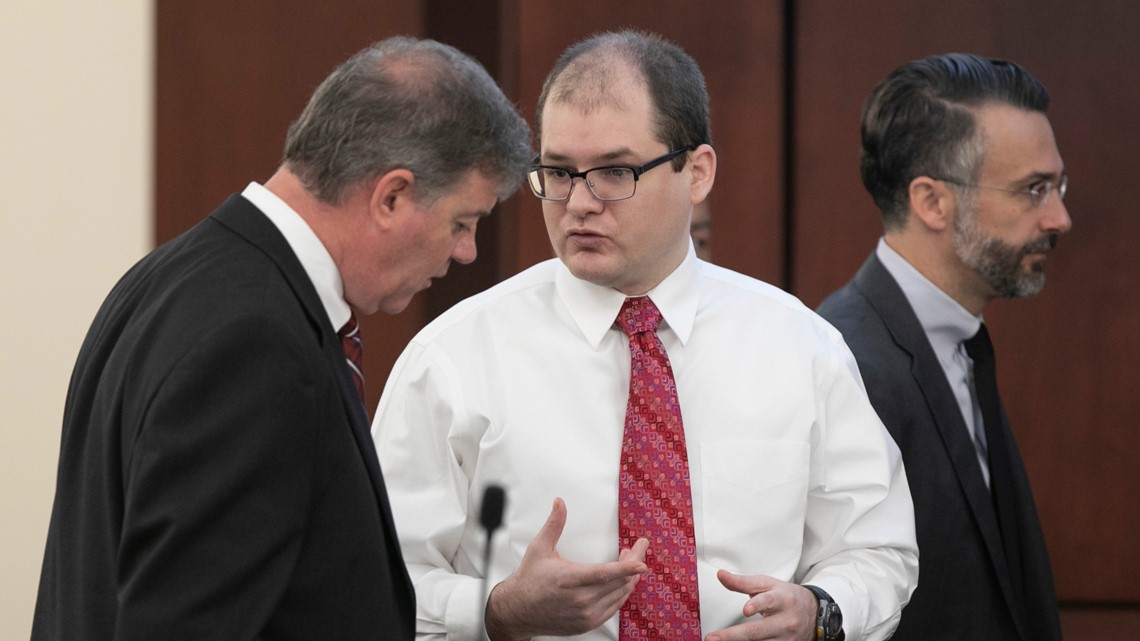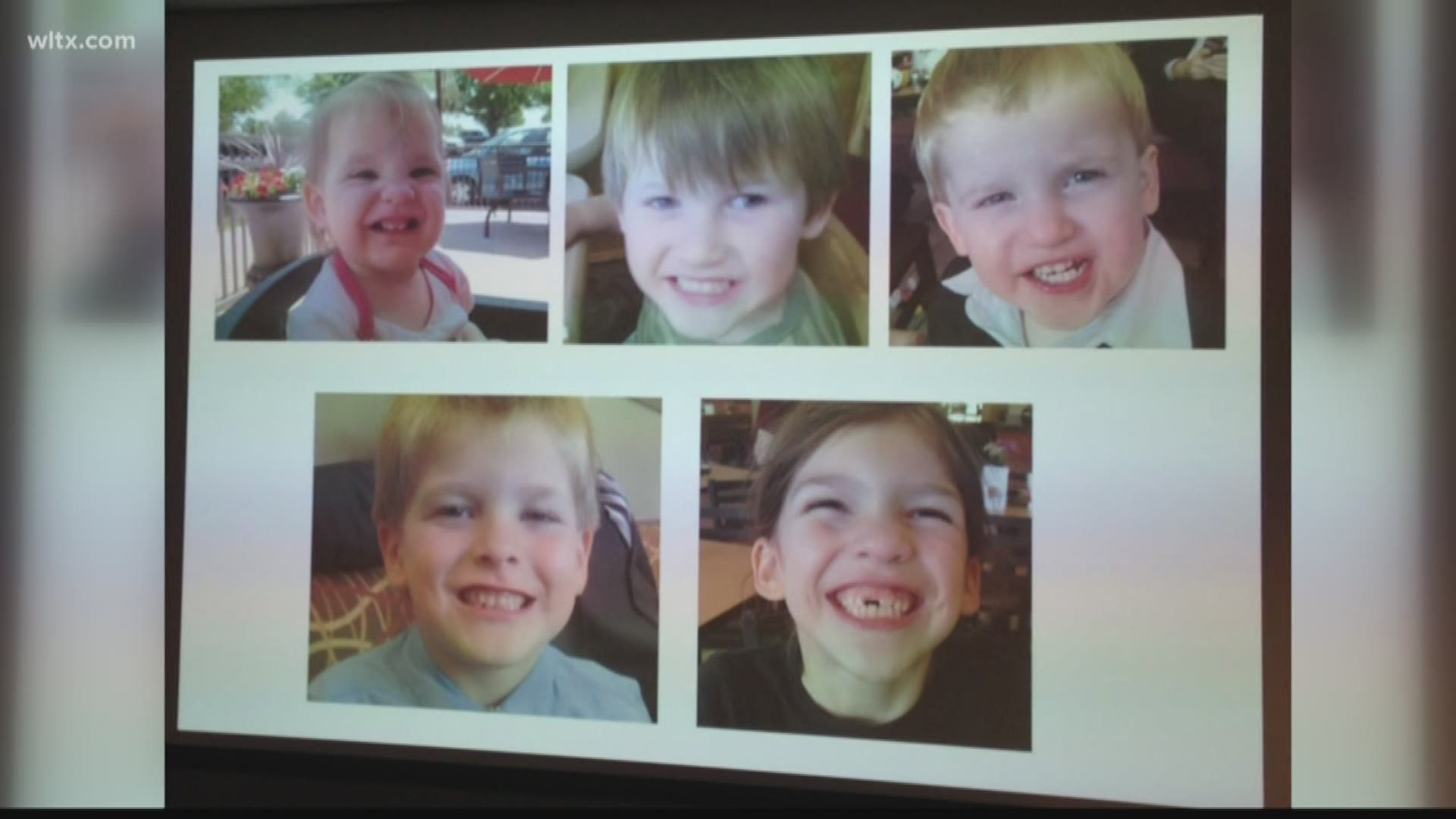LEXINGTON, S.C. — Jurors deciding if the man who killed all five of his children will get the death penalty heard Friday from former teachers of the kids, who said the children's deaths still haunt them to this day--so much so, one of them said he'll leave the school where he works.
It was an emotional day of testimony in the sentencing stage in the Tim Jones Jr. in a Lexington County.
On Tuesday, the jury found Jones guilty on five counts of murder for killing his children — Abigail Elaine, 1; Gabriel, 2; Nahtahn, 6; Elias, 7; and Merah Gracie, 8 — on August 28, 2014.
That same jury is now having to decided if he deserve life in prison or the death penalty for his crimes.
THE PENALTY PHASE CONTINUES
Thursday ended with emotional testimony from Janice Ricard, the assistant principal at Saxe Gotha Elementary School where Merah, Elias and Nathan attended. She was a character witness for the children and gave a brief impression of the three oldest children as happy, bright and outgoing youngsters that were loved at the school.
Ricard read from a collection of Merah’s school papers and — with a voice sometimes breaking with emotion — recounted how the school pulled together in September 2014, after the murders:
- In the 2014-15 school year, the three children’s photos are included in the school’s yearbook.
- One of Elias’ kindergarten teachers painted a mural with a beach theme in the learning commons. The mural, called Jones Beach, has five sets of footprints and five turtles (Elias’ favorite animal), with reading areas and chairs.
For Friday’s first witness, Deputy solicitor Suzanne Mayes calls Jacqueline Moran, Elias’ first grade teacher at Saxe Gotha in 2013. That year was Moran’s second year in the teaching profession.
She tearfully testified that Elias was everybody’s friend, loved school, loved to learn.
She remembers him as one of the smaller kids in class that gravitated toward her, sat up front in class, and wanted to sit with her at lunch. Moran took on a motherly role with the boy, eating breakfast with him and taking a special interest him.
“He was my little buddy,” she said.
“Everyone loved Elias. He was a really good artist and tried to teach others how to draw like him.”
Shown a photo of Elias grinning in the camera at Buddy Time at school, Moran says that that’s the smile she remembers, the boy smiled all the time.
During the presentation of Moran’s slide show of classroom photos of Elias, Tim Jones is constantly looking up at the screen.
Moran describes Elias as the person who didn’t want anyone to feel left out: “he was everyone’s friend.”
When Moran reads an assignment where Elias writes about his brother Nathan — about how he loves Nahtahn, loves God, and thanks God for his little brother — Tim Jones removes his glasses and wipes his eyes.
As Moran presents some of Elias’ schoolwork to the jury, jurors are engaged, smiling with her and laughing with her at some of his writings and her remembrances of the boy.
“This is something I struggle with daily. I see his friends. It's hard. Somedays are easier, but he’s always there. It's hard for me to put into words."
Defense attorney Rob Madsen asked if Jones came to parent night at Saxe Gotha. Moran said Elias was excited when he and his father came to those nights because they went out to dinner afterwards.
Solicitor Rick Hubbard calls Jonathan Stone, Nahtahn’s kindergarten teacher at Saxe Gotha in 2013.
Stone said Nahtahn was a quiet kid who lit up the room when he walked in, and was very lovable and approachable.
He developed relationship with Nathan because he seemed he needed more support than others.
Communicated very little with Jones — usually there are daily emails or daily communication folders sent home to parents. Stone had no one-on-one meetings with Jones although the teacher testified that typically parents are really involved in a child’s first year at school.
Stone testified that he saw Jones with Nahtahn — but Jones never praised the boy, didn’t ask Stone about his progress or what the boy might need to succeed.
The teacher saw the boy become more emotional as the school year progressed. Nahtahn needed hugs and to be told school was a safe place. Stone thought the boy was sometimes smiling just to smile, that he was unhappy.
The boy described punishment at home, involving physical activity — burpies (drop, pushup and jump up) and running in place. Stone felt like Nahtahn was always getting on trouble.
Towards the middle to end of the school year, when Nahtahn would get a frowny face notes based on his behavior in class, Nahtahn would come in the next day very emotional. After this happened once or twice, Stone would only send smiley face notes home and deal with Nahtahn’s behavior (or misbehavior) at the school.
Nahtahn loved school and loved Woody from “Toy Story” movies. The boy wrote about the character for a school assignment and drew a picture.
Stone wanted Nahtahn to know he was loved and part of a family. The teacher became concerned he noticed that Nahtahn wasn’t eating properly — he came to school with bread and grapes or cold pizza for lunch. Saxe Gotha teachers began giving Nahtahn more food.
Stone noticed bruises around Nahtahn’s neck and arms and, along with Saxe Gotha administration, documented the injuries for DSS in early 2014.
When Stone asked Nahtahn about the bruises, Stone said the boy appeared afraid and told him that his father had done it.
During Stone’s testimony, Jones looks straight ahead.
Stone continued. The next day, Nahtahn was distant, quiet. Stone attempted to talk to Nahtahn but the boy said his father didn’t want him to talk.
There was no communication between Stone and Tim Jones from that day forward.
Jones never signed Nahtahn’s homework; Stone testified that Nahtahn once brought back homework in heavy plastic notebook that had been ripped in two — the boy said his father did it.
Stone testified that Jones did not attend Nahtahn’s kindergarten graduation, even though the boy was excited to be headed to the first grade.
Teachers from Saxe Gotha sitting in the courtroom are wiping away tears listening to Stone’s testimony.
Stone breaks down in tears on the stand as he says he remembers having to go home the day he heard about the deaths of the Jones children. He had a small child at home that reminded him of Nahtahn.
He says that he’s leaving Saxe Gotha Elementary because he needs to move on, he can’t stand teaching there anymore.
The court takes a brief break after Stone’s emotional testimony.
After the break, Mayes called Amy Shearer, works with parent and students at Saxe Gotha as instructional assistant. She puts together homework folders for teachers and sends communication back and forth to parents. She worked with Nahtahn, helping with math and reading skills.
“Nahtahn was the sweetest… every day I got a hug.”
Shearer remembers Nahtahn’s smile, and that his shoe laces were never tied. She says the boy wore the same shoes every day — the laces were ragged because they were never replaced and the shoes had holes in them.
She noticed the bruising on the boy’s neck. She asked the boy what happened and she testifies “Nahtahn said his father grabbed him around his neck and slammed him against a wall because he had broken one of Elias’ toys.”
Jones is sitting staring ahead as Shearer describes the injuries on Nahtahn and her reaction to them.
Shearer contributes to the DSS report of May 2014.
She testifies that after Jones is notified of the DSS report, Nahtahn seems withdrawn. She also recounts seeing Nahtahn’s heavy plastic schoolwork notebook being ripped in two after it was sent home with the boy.
There is no more direct communication with Jones about Nahtahn for the rest of the school year.
Mayes has Shearer go over Nahtahn’s academic records — he won numerous awards for his computer skills and seemed to be a very bright student.
After the DSS report, Nahtahn seemed tired. He came in on a Monday morning after making Shearer a necklace at church. She loved him “just a little bit harder” because she knew his mother was not in the home.
Mayes asks Shearer about the personal impact that Nahtahn’s death had on her: “It was months before I could wake up not screaming from the nightmare. To this day I feel guilty that I saw bruises and I made the report and he’s not here today.”
Jones seems unmoved. Defense does not respond.
Hubbard enters into evidence the five indictments for murder and reads the children’s names from the documents and the guilty verdicts from the indictments.
The State rests its case in the penalty phase.


>>>>>>>>>>>>> THE PENALTY PHASE: THE DEFENSE
Before breaking early on Friday, the defense team did offer two character witnesses for Tim Jones Jr.: Kerry Breen, a former reverend with the Assemblies of God Church and Central City Church in Columbia; and Barry Sowards, a sergeant with the Lexington County Sheriffs Department.
Attorney Boyd Young called Breen to testify.
Breen was contacted by Casey Secor and Jones' defense team in 2016 to provide spiritual support for Jones. The reverend testified that he visited Jones between 10 to 20 times in Kirkland and Lee correctional facilities.
During the visits Breen would read and discuss Scripture with Jones, teach him Christian songs to sing, and close each meeting with prayer.
Breen testified that it was his impression that Jones had a very literal interpretation of Scripture — it was all black and white, no gray areas -- and Jones needed to understand that people make mistakes and there has to be some forgiveness — not absolutes.
He also testified that Pentecostals believe in redemption in Heaven and that Jones believes he will be reunited with his children.
Breen also believes that Jones could be a good influence on others.
Sol;icitor Hubbard asked Breen if nothing in his faith allows for the mistreatment or brutal beating of children. Breen answered "no." If children have a special place: Breen answered "yes."
Defense's Rob Madsen called Sowards to talk about the sergeant's experience since he was placed in charge of Jones' transportation team. Sowards has been serving as Jones' handler since his arrest in 2014.
He was on the almost 9-hour drive that transported Jones from Mississippi in 2014. Since his arrest, there was a heightened level of security for Jones because of the charges against him for killing the children.
In the past seven weeks, Sowards' job included overseeing Jones' coming and going from jail to court, making sure Jones is on time and properly dressed. It was in this capacity that Sowards noticed Jones had a few facial expressions Sowards was not familiar with so he approached Jones and asked him if he was feeling OK.
He testified that he told Jones if he wasn’t OK, he needed to say something. Sowards said that Jones told hime that he was hearing voices and Sowards reported it. As a result, Jones’ dosage of Geodon was changed and Jones appeared to get better.
Sowards also testified that Jones has been a compliant prisoner, does what Sowards asks, has been quiet and courteous.
After this testimony, the defense asked for a break until Monday morning to gather their witnesses.
Defense testimony will resume Monday morning at Lexington County Courthouse.

